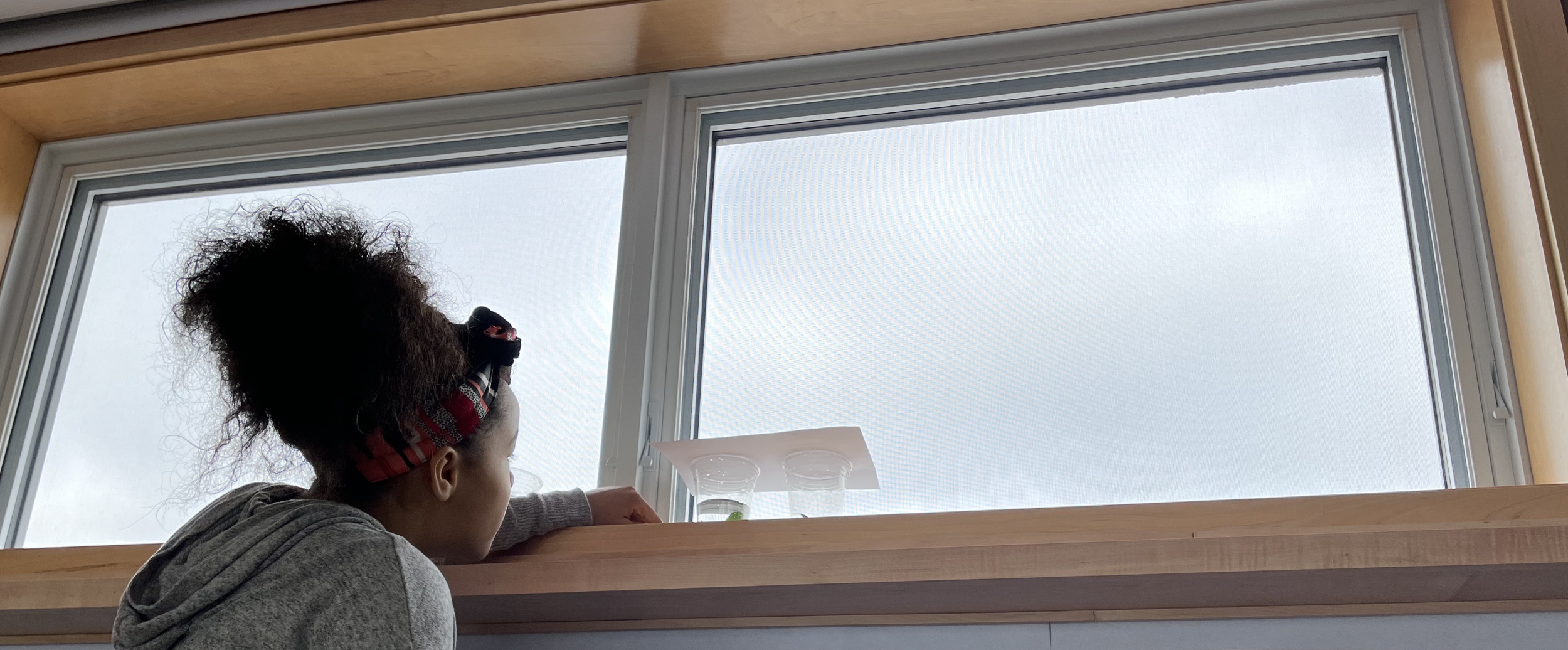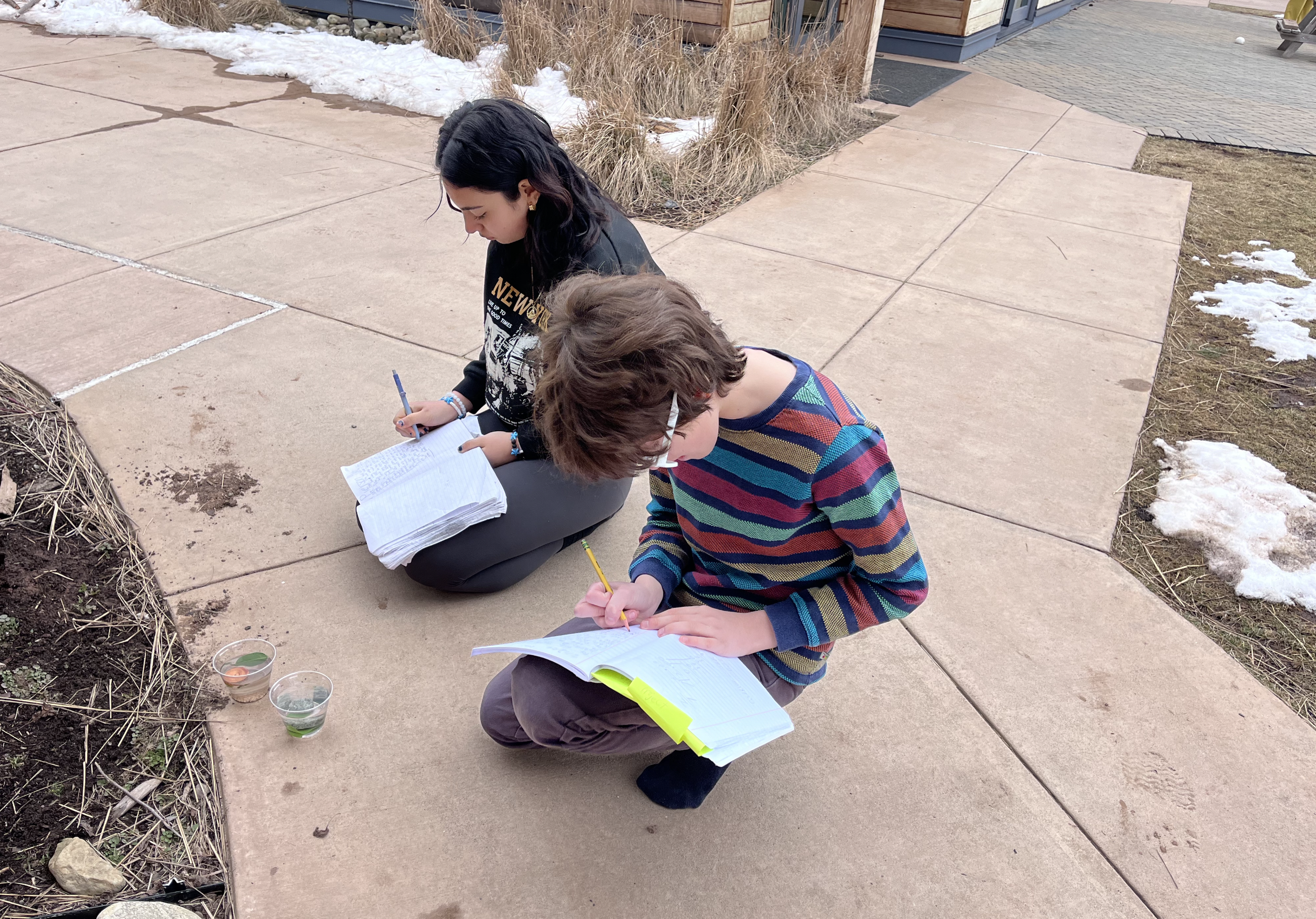
Interdisciplinary Science Blog



Photosynthesis: An Exploration from Molecular Structures to Radiocarbon Dating
By Jennifer Staple-Clark, Founder and Executive Director
Our Grade 5/6 students embarked on an in-depth exploration of photosynthesis through a variety of perspectives, all building upon their growing understanding of chemical processes. The journey began with a focus on light, prisms, the electromagnetic spectrum, and an exploration of color creation through pigments and nanostructures. Then, we welcomed Chemistry Professor and NYU President Emeritus Andrew Hamilton for a Zoom Lunchtime Conversation. Serendipitously, he shared with our students that his passion for chemistry began as a child when he realized that hemoglobin in animals and chlorophyll in plants have such similar chemical structures. The next morning, our students arrived to an Enticement of the hemoglobin and chlorophyll molecular structures that Andrew Hamilton introduced. Our students identified the elements that they recognized in each molecule, and they thought about what the molecules are and where they are found. This moved us into thinking about all that we already know and have encountered with photosynthesis as a process through the years at Slate School, and then we transitioned into the chemical and molecular processes of photosynthesis. Our students watched a 4-minute “window to wonder” from Beyond The Elements, a PBS Nova documentary that introduced photosynthesis as the most important process on Earth. It was a true window to wonder about the evolution and impact of photosynthesis, and the students were excited to delve into the complexity and awe of it all!
In groups, students read recent press releases from Science Daily about scientific research related to photosynthesis, before coming back together as a class to share out about what they learned from their article. In the process, the students thought about the evolution of photosynthesis over billions of years, bacteria and algae that photosynthesize, photosynthesis's use of visible light, and recent research about photosynthesis by some bacteria that harness far-red light.
On a subsequent day, our students worked in pairs to design their own experiments to demonstrate photosynthesis. We began by thinking about Thomas Edison's quote that they've thought about in the past: “I have not failed. I've just found 10,000 ways that won't work.” Students were invited to use any materials inside or outside that they thought would be useful to their experiment. The students thought about their experimental design, controls and variables, hypothesis, and then they put together their experiments. The classroom was abuzz, with students collecting snow, soil, leaves, plants, and more, and one group announced that they needed to find bugs and rushed to our Sprout greenhouse because they thought they could find bugs in that environment! Why bugs, I wondered? I soon learned why, and they had an intriguing reason! A short time later, the class came back together, and the groups shared what they put together for their experiments, as well as their hypotheses. New ideas sprung out of the sharing, and they began thinking of adjustments and enhancements that they would like to make to their experiments. Over the course of a week, each student group recorded observations and drew conclusions about their experiments.
Without having previously known about Joseph Priestly's 1770s experiments, one of our student groups thought of an experimental design that mimicked Priestly's groundbreaking experiment. Priestly was interested in how animals interact with air, and he thought that animals change the composition of air. Priestly had two identical closed systems with a mouse inside, and he put a plant in one of the jars. Priestly found that the mouse with the plant survived in the sealed environment, and so he concluded that plants return to air whatever animals remove from it when breathing. Without having known about Priestly's experiment, our student group thought of a nearly identical experiment, but instead proposed bugs instead of mice. This is why they went rushing to our greenhouse looking for bugs! We don’t have experimental bugs, and so with that ethical consideration in mind, we kept this experimental design as a theoretical plan instead of an opportunity for implementation. However, based on Priestly’s similar experiment, we could imagine what would likely happen. The student group shared their experimental design with the rest of the class, and then we all learned about Priestly's 1770s experiment, and we looked at a diagram of Priestly's experiment from his 1774 book.
At Slate School, we avoid the rote process of telling students about science knowledge, and instead we bring students on a journey to understand the origins of scientific discovery. Science is constantly advancing, and by understanding how we’ve reached our current levels of understanding, we know that our students will have groundbreaking ideas like many of the scientists who they’re discovering. When thinking about photosynthesis, we therefore just had to think about Jan Ingenhousz's 1790s experiment that identified photosynthesis! He placed a plant underwater in a clear container, and found that bubbles form (due to photosynthesis) when placed in sunlight. Ingenhousz theorized that the bubbles might be what plants produce that allowed the mouse to survive in Priestly's earlier experiment. While thinking about controls and variables, our students considered what materials they'd need to design their own experiment that was informed by Ingenhousz's experiment. The students then jumped into designing their own experiments, and – as with all experiments at Slate School – every experiment was unique from the others. Some students set up their experiment outdoors, while others used classroom lamps, and others used the classroom window sills. All of the designs had a variety of different elements, and the students were thrilled when some of the cups began displaying oxygen bubbles like Ingenhousz's experiment!
Photosynthesis offered so many opportunities, and it also brought us to the opportunity to fully understand a question that a student had asked months ago when we were thinking about pigment in ancient art: how do we know how old something is? The process of carbon dating is only possible because of photosynthesis, so we were able to connect photosynthesis with many recent and current project topics related to Archaeology, Ancient Egypt, Maya Civilization, Mesopotamia, Ancient Chinese Medicine, and other topics! The students began with morning Enticements that included selections from recent archaeology carbon dating journal articles as well as sections and images from Willard Libby's original 1949 journal publication revealing his discovery of carbon dating. Our students had many wonderings and questions, which led us into thinking about how photosynthesis enables carbon dating. They watched a brief “window to wonder” video about carbon dating and then role played the protons and neutrons during the cosmic radiation conversion of Nitrogen to Carbon-14. They next delved into what a half life means by working in small groups to demonstrate a half life with pasta and a timer. Each group had a unique variation, and some groups shared out about their process. The class thought briefly about half lives that they may have personally encountered, such as the half-life of medication. The class further delved into the ages and percentages of Carbon-14 in artifacts from science journal articles, like a 5,700-year-old antler, Ötzi the Iceman, and bird bone instruments dating back more than 11,700 years. The students were excited to tie the study of photosynthesis to various historical and archaeological topics.
This interdisciplinary exploration of photosynthesis deepened student understanding of the photosynthesis process that they’ve heard about for years. Throughout, the students engaged in a dynamic and learner-led process that was fueled by curiosity, creativity, and exuberance for experimentation.
About The Blog Author, Jennifer Staple-Clark
For nearly 25 years, Jennifer Staple-Clark has been a leader in nonprofit innovation, and she currently leads two nonprofit organizations: Unite For Sight and Slate School. In 2000, Jennifer, who was then a sophomore at Yale University, founded Unite For Sight in her dorm room. Unite For Sight is now a leader both in global health education and in providing cost-effective care to the world's poorest people.
A cum laude graduate of Yale University, Jennifer received a Bachelor of Science Degree in Anthropology as well as in Molecular, Cellular, and Developmental Biology. Early in her career, Jennifer taught high school environmental science and chemistry, where she brought project-based learning to the independent school where she was teaching. She received a national educator award for her work. After dedicating herself to being a high school educator, Jennifer completed two years of medical school at Stanford University School of Medicine before shifting to pursue her passionate interest in global health and eliminating patient barriers to care through building the nonprofit Unite For Sight into an organizational leader in the field. After more than a decade dedicated solely to Unite For Sight, in 2017, Jennifer founded Slate School, an innovative 501(c)3 nonprofit K-12 curiosity-driven and nature-based school in Connecticut. As part of her work as Founder and Executive Director of Slate School, Jennifer draws on her science, medical, anthropology, and public health background to integrate curiosity-driven, interdisciplinary chemistry, biology, and physics into the Upper Elementary classrooms. She is also closely involved in the Upper School interdisciplinary curriculum development.